Tennis Elbow Exercises To Avoid Introduction
If you are one of the many people stuck in a frustrating cycle of tennis elbow pain, where even your best efforts to address this condition seem to backfire constantly? You’re not the only one out there.
That nagging ache on the outside of your elbow makes even the simplest everyday tasks difficult, and to make matters worse, it could actually be the exercises you think will improve your condition that might actually be making things worse.
In this insightful post, we uncover the common exercises that could be at the root of your tennis elbow. After reading our guide, you’ll know exactly which movements to ditch from your routine, to finally get some real relief and get back to living the life you love.
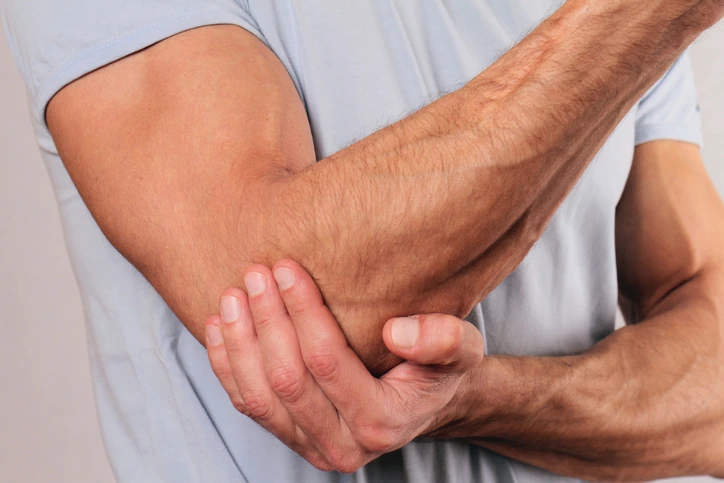
Quick Summary:
- 🚫 Avoid These 7: Stress balls, heavy wrist curls, pull-ups, straight-elbow cables, straight-arm raises, heavy barbell curls, and traditional push-ups all aggravate tennis elbow.
- ✅ Do Instead: Isometric holds, low-resistance eccentric exercises, nerve glides, modified push-ups, and forearm massage support healing.
- 💪 Key Insight: Tennis elbow (lateral epicondylitis) results from repetitive strain on forearm extensor tendons—especially the ECRB tendon.
- 🏥 Get Help: If pain persists despite rest and modification, professional assessment at Hand Therapy Experts can prevent complications.
What is Tennis Elbow and Why Certain Exercises Can Make It Worse
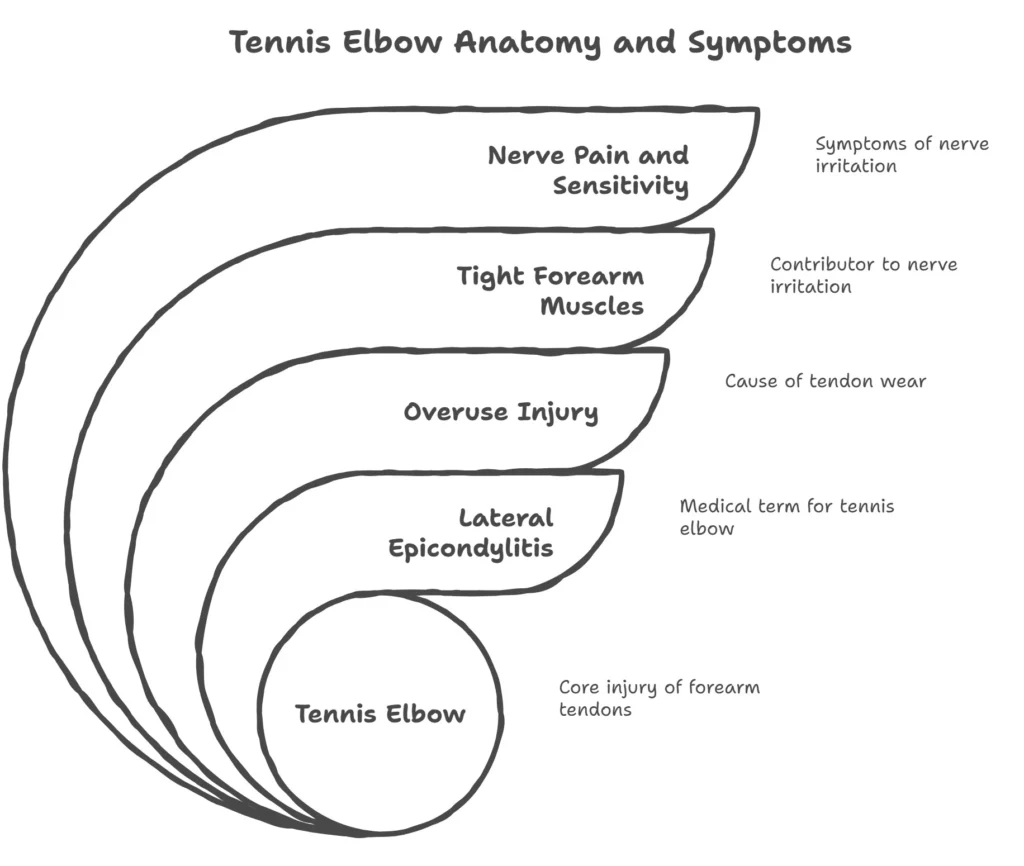
To address a common myth, you don’t have to actually play tennis to develop tennis elbow.
Otherwise known as ‘Lateral Epicondylitis’, it’s a common overuse injury that happens when tendons in your forearm get worn out from repeated strain.
For some people, having tight forearm muscles can also irritate the radial nerve, making things like nerve pain and increased sensitivity pretty common symptoms too.
So, What Actually Causes It?
Here’s what happens: Whether it’s from gripping, heavy lifting, or squeezing exercises, like when using a stress ball, all these repetitive actions start to create micro-tears in your tendons. And as you can probably guess, this, in turn, causes ‘repetitive strain overload’ on the already inflamed area.
Think of it like a rope that’s been pulled too many times in the same direction – exactly the same concept!
The most commonly affected structure is the extensor carpi radialis brevis (ECRB) tendon, where it hooks onto the elbow – the outside bit at the back of the elbow.
This gradually becomes irritated and weakens if not managed early. In some cases, tight forearm muscles can also irritate the radial nerve, adding symptoms such as nerve pain and sensitivity.
For some people, having tight forearm muscles can also irritate the radial nerve, making things like nerve pain and increased sensitivity pretty common symptoms too.
Common risk factors include:
- Repetitive computer or mouse usage.
- Professions involving repetitive gripping and twisting, such as plumbing, carpentry, or butchery.
- Repetitive overhead throwing like in baseball, javelin or frisbees.
- Weightlifting with poor form or too much weight.
- Playing musical instruments.
- Even excessive gardening!
The key takeaway is that any activity involving repetitive gripping, wrist extension, or lifting can be the culprit.
The 7 Exercises We Recommend You Avoid To Relieve Pain
To address a common myth, you don’t have to actually play tennis to develop tennis elbow.
Otherwise known as ‘Lateral Epicondylitis’, it’s a common overuse injury that happens when tendons in your forearm get worn out from repeated strain. So, what are some of the key offenders?
Squeezing A Stress Ball For Too Long
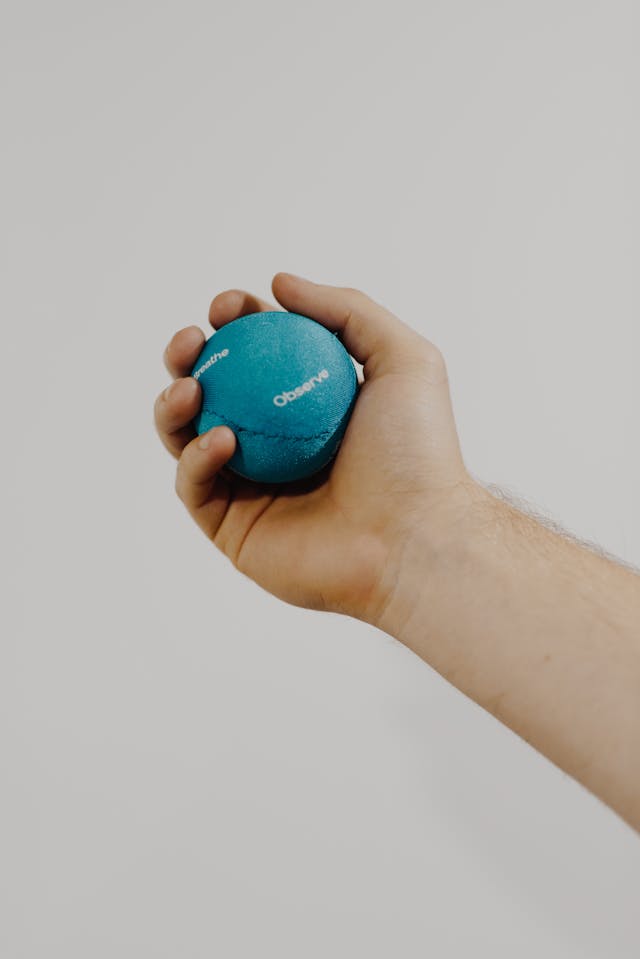
Why it hurts:
Squeezing a stress ball or a hand gripper uses the forearm extensor muscles, which contribute to tennis elbow pain. Overuse of these muscles will increase the inflammation in the ECRB tendon, thus worsening tennis elbow pain.
What to do instead:
We recommend you try some gentle finger extensions or use some therapy putty that’s got minimal resistance – that way you can keep your joints loose and supple without putting too much strain on those overworked extensors.
Overdoing Heavy Wrist Curls
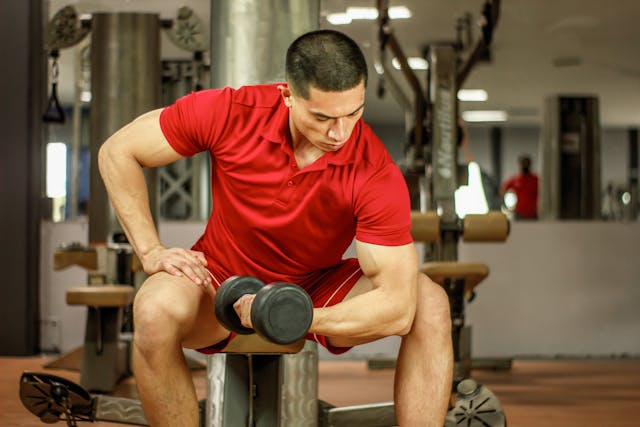
Why it hurts:
Heavy wrist curls place excessive stress on the forearm extensor tendons, especially when the tendon is already irritated or weakened from tennis elbow.
When these tendons cannot tolerate high loads, heavy resistance training can trigger flare-ups or even contribute to small tears in the ECRB tendon. A common mistake people make in the gym is using heavy dumbbells for wrist curls or bar hangs.
What to do instead:
Forget about using heavy weights for now and go for light resistance or bodyweight exercises that let you move your wrists in a pain-free zone. Try to keep your range of motion nice and gentle to help give your tendons a break.
Pull-ups that Aggravate

Why it hurts:
Pull-ups place the forearm in a rotated position with the elbow straight, loading the extensor tendons under significant tension.
This position is one of the most aggravating for tennis elbow sufferers because it involves both strong gripping and a load-bearing movement. Pain is often worse during the lowering phase of the movement, as the extensor tendons are lengthened under load, also known as eccentric loading, a common trigger for tennis elbow pain flare-ups.
What to do instead:
Try assisted pull-ups, neutral-grip lat pulldowns, or rows that keep your elbows slightly bent to reduce forearm strain.
Cable Exercises With A Straight Elbow
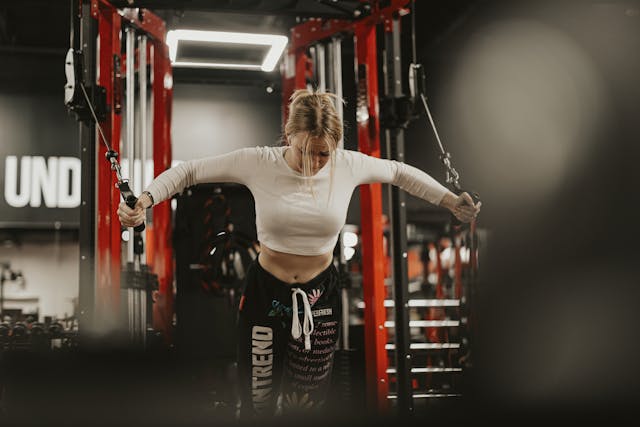
Why it hurts:
Cable-based gym exercises such as wood chops and straight-arm pulldowns also strain the forearm extensor tendons when performed with the elbow locked straight.
The heavier the resistance, the more force is transmitted through the extensor tendon attachment at the elbow. These movements often cause pain because the tendon is not yet strong enough to tolerate high loads during recovery.
What to do instead:
Perform the same exercises with a slightly bent elbow to reduce tendon loading, or choose alternative exercises like bent-arm cable rows that distribute force more evenly.
Deltoid Raises With A Straight Arm

Why it hurts:
Even though side raises and front raises are designed to strengthen the shoulder, performing them with a straight elbow still puts a lot of strain on your wrist extensor muscles.
The longer you hold onto that weight and the more static you are, the more stress is being sent down your forearm, which can increase the strain on those tendons, especially when performed with heavy dumbbells. Which, if you are suffering from tennis elbow, is not exactly good news.
What to do instead:
Just do your deltoid raises with a slight bend in the elbow or use lighter weights and try to keep your movements nice and smooth – that way you can avoid overloading those poor tendons.
Heavy Barbell Bicep Curls and Other Exercises that Grasp Too Hard
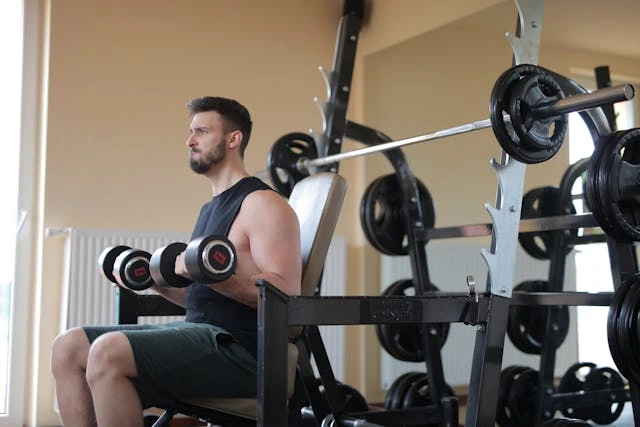
Why it hurts:
This is arguably the biggest offender in the gym. A heavy barbell or dumbbell forces you to grip tightly, which places an immense strain directly on the already-inflamed tendon attachment at your elbow.
Those forearm extensor muscles are working overtime when you grip the barbell tight, even though they’re not the muscles you’re trying to target – they’re just trying to help you out. When you clench a barbell or heavy dumbbell in your hand, you’re essentially piling on the strain when you have a dodgy elbow. It’s the same old problem – your elbow is already irritated, and this just makes it worse.
What to do instead:
Try using light dumbbells for some hammer curls; these help take the pressure off your grip.
Traditional Push-Ups & Bench Press
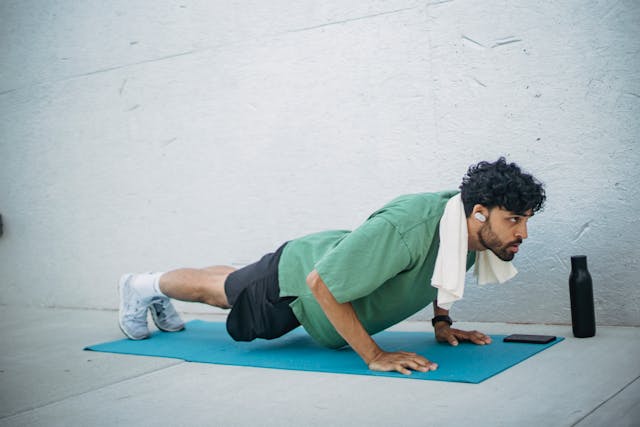
Why it hurts:
Push-ups are a fantastic bodyweight exercise, but they place your wrists in extension and demand significant stability from the forearm, transferring load directly through the elbow. The same goes for a heavy barbell bench press.
The extended wrist position stretches and irritates the tendon. As you lower your body, the tension increases sharply, often causing a sharp pain in the elbow at the bottom of the movement.
What to do instead:
Perform push-ups on fists or with push-up handles to keep your wrists in a neutral position. This simple change can dramatically reduce elbow strain.
Your Quick-Reference Guide: Exercises to Swap
This table gives you a clear, at-a-glance action plan to modify your workout immediately.
| 🚫 Exercise to AVOID | ⚠️ Why It’s Bad for Tennis Elbow | ✅ Safer ALTERNATIVE |
|---|---|---|
|
|
|
Better Alternatives – What You Can Do Instead of Giving Up on Exercising
Instead of just avoiding exercise altogether, we recommend doing movements that are a lot easier on your tendons and actually help them to heal at the same time as building strength.
Isometric Elbow Exercises

Isometric exercises involve holding tension without moving the joint and are very effective in early tennis elbow rehabilitation. These exercises help ease the pain by getting your tendons to work without putting too much stress on them, which in turn helps your tendons get more resilient over time.
When performed the right way, isometrics can even provide some relief while you’re still exercising.
Low Resistance Eccentric Elbow Exercises

Eccentric training (slowly lowering a light weight under control) helps tendon healing by increasing blood flow and activating collagen repair.
When performed with low resistance and correct technique, eccentric exercises gradually rebuild tendon strength without causing flare-ups. These are often introduced once elbow pain starts to improve.
Radial Nerve Glides

Some people with tennis elbow may also experience radial nerve tension that can mimic tendon pain. As your radial nerve runs down your arm, tight or overactive muscles in your forearm can get in the way or even compress the area and your nerve.
This is where Radial nerve glides can help, providing super-gentle movements that help get the nerve mobile again. This helps reduce nerve-related symptoms like burning, tingling, or sharp pain.
Forearm Extensor Massage

When your forearm extensor muscles get all tight, it amplifies tendon irritation, making it that much worse. We recommend using a massage ball to release some of that tightness and get the circulation going to decrease the pain.
This is just one simple trick that also helps prepare the tendon for loading exercises and everyday activities.
How Do I Know When To Get Professional Help?
If you’ve tried resting and modifying your exercise routines and you still find you are experiencing pain, we recommend seeking help early to prevent any further complications. Unfortunately, self-care can only get you so far for this condition and is not always enough, especially for more complicated cases.
At Hand Therapy Experts, we have years of clinical experience in providing effective tennis elbow treatment for this condition and can assess your strength, mobility and tendon irritability at our clinic in Sydney’s lower North Shore.
We provide patients with an effective treatment plan, which may include:
- Manual therapy to improve tissue mobility.
- Provide elbow bracing to offload the inflamed tendons and provide relief while supporting the healing process.
- Education on activity modification to prevent re-injury.
- Provide you with targeted exercise programmes for lateral epicondylitis.
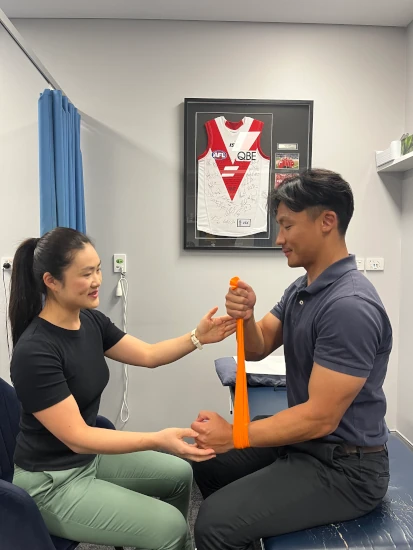
Recovery Tips Beyond the Gym
- Ice it up: Pop an ice pack on for 10-15 minutes a few times a day; this should help reduce any early inflammation and pain.
- Get the right gear: Swap out those heavy old tools and use ergonomic ones instead at work. Your body will thank you!
- Try a counterforce strap: One of those tennis elbow straps worn just below the area that’s killing you can do wonders for easing tension on your tendons during the day.
How To Prevent Re-Injury For The Long Term
- Warm-Up Properly: Never jump into heavy lifting cold. Warm up your wrists, elbows, and shoulders dynamically.
- Strengthen Your Forearms and Shoulders: Strengthening the right shoulder and forearm muscles will reduce load on your elbow.
- Stay Mindful of Form: Never sacrifice good technique for heavier weight. This is your number one defence against all weightlifting injuries.
The Final Serve (Takeaway)
Dealing with tennis elbow can feel like a frustrating setback, especially if you are a regular at the gym. Because of this, however, it is also an opportunity to train smarter by cutting these seven exercises that can cause you more harm than good.
Remember, healing is a journey. Be patient with your body, listen to what it’s telling you, and don’t hesitate to ask for professional assistance.
For more information, please visit our Tennis elbow FAQ page, or contact Hand Therapy Experts at 1300 33 HAND or book a consultation today!
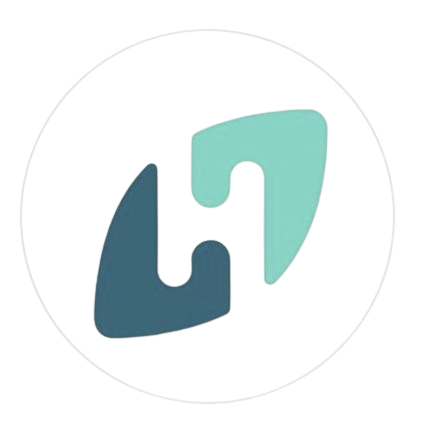
About The Author
Chen Li is an Accredited Hand Therapist based in Sydney’s North Shore, with over 10 years of experience in assessing and treating conditions of the hand, wrist, and elbow.
She has extensive expertise, offering effective and conservative hand therapy treatment while supporting patients through post-surgical rehabilitation.

